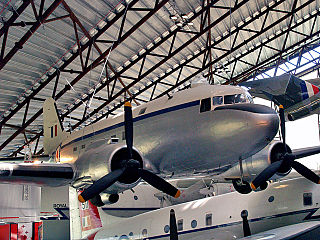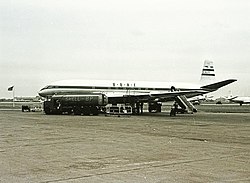
Imperial Airways was an early British commercial long-range airline, operating from 1924 to 1939 and principally serving the British Empire routes to South Africa, India, Australia and the Far East, including Malaya and Hong Kong. Passengers were typically businessmen or colonial administrators, and most flights carried about 20 passengers or fewer. Accidents were frequent: in the first six years, 32 people died in seven incidents. Imperial Airways never achieved the levels of technological innovation of its competitors and was merged into the British Overseas Airways Corporation (BOAC) in 1939. BOAC in turn merged with the British European Airways (BEA) in 1974 to form British Airways.

The de Havilland DH.106 Comet is the world's first commercial jet airliner. Developed and manufactured by de Havilland in the United Kingdom, the Comet 1 prototype first flew in 1949. It features an aerodynamically clean design with four de Havilland Ghost turbojet engines buried in the wing roots, a pressurised cabin, and large windows. For the era, it offered a relatively quiet, comfortable passenger cabin and was commercially promising at its debut in 1952.

The Bristol Type 175 Britannia is a retired British medium-to-long-range airliner built by the Bristol Aeroplane Company in 1952 to meet British civilian aviation needs. During development two prototypes were lost and the turboprop engines proved susceptible to inlet icing, which delayed entry into service while solutions were sought.

The Boeing 377 Stratocruiser was a large long-range airliner developed from the C-97 Stratofreighter military transport, itself a derivative of the B-29 Superfortress. The Stratocruiser's first flight was on July 8, 1947. Its design was advanced for its day; its relatively innovative features included two passenger decks and a pressurized cabin. It could carry up to 100 passengers on the main deck plus 14 in the lower deck lounge; typical seating was for 63 or 84 passengers or 28 berthed and five seated passengers.

The Avro York was a British transport aircraft developed by Avro during the Second World War. The design was derived from the Avro Lancaster heavy bomber, several sections of the York and Lancaster being identical. Due to the importance of Lancaster production, York output proceeded slowly until 1944, after which a higher priority was placed upon transport aircraft.

BOAC Flight 781 was a scheduled British Overseas Airways Corporation passenger flight from Singapore to London. On 10 January 1954, a de Havilland Comet passenger jet operating the flight suffered an explosive decompression at altitude and crashed, killing all 35 people on board.

BOAC Flight 911 was a round-the-world flight operated by the British Overseas Airways Corporation (BOAC) that crashed near Mount Fuji in Japan on 5 March 1966, with the loss of all 113 passengers and 11 crew members. The Boeing 707 jetliner involved disintegrated mid-air shortly after departing from Tokyo, as a result of severe clear-air turbulence.
East African Airways Corporation, more commonly known as East African Airways, was an airline jointly run by Kenya, Tanzania, and Uganda. It was set up on 1 January 1946, starting operations the same year. The airline was headquartered in the Sadler House in Nairobi, Kenya. The corporation was dissolved in 1977 amid deteriorated relations among the three countries.

Pan American World Airways Flight 202 was a Boeing 377 Stratocruiser aircraft that crashed in the Amazon Basin about 281 nautical miles southwest of Carolina, Brazil on April 29, 1952. The accident happened en route from Rio de Janeiro, Brazil, to Port of Spain, Trinidad and Tobago, during the third leg of a four-leg journey. All 50 people on board were killed in the deadliest-ever accident involving the Boeing 377.

Far Eastern Air Transport Flight 103 was a flight from Taiwan Taipei Songshan Airport to Kaohsiung International Airport that crashed on 22 August 1981, killing all 110 people on board. The Boeing 737-222 aircraft disintegrated in midair and crashed in the township of Sanyi, Miaoli. It is also called the Sanyi Air Disaster. The crash is the third-deadliest aviation accident on the Taiwanese soil, behind China Airlines Flight 676 and China Airlines Flight 611.

On March 4, 1966, Canadian Pacific Air Lines Flight 402 (CP402) struck the approach lights and a seawall during a night landing attempt in poor visibility at Haneda Airport in Tokyo, Japan. Of the 62 passengers and 10 crew, only 8 passengers survived.

The 1957 Aquila Airways Solent crash occurred on the Isle of Wight in England on 15 November. With 45 lives lost, at the time it was the second worst aircraft accident within the United Kingdom, then at the time the worst ever air disaster to occur on English soil.

Aden Airways was a subsidiary of British Overseas Airways Corporation (BOAC) based in Aden. It was in operation from 1949 to 1967.

Cyprus Airways Flight 284 was a de Havilland Comet that exploded during a flight to Nicosia International Airport on 12 October 1967 after a bomb detonated in the cabin. The airliner crashed in the Mediterranean Sea and all 66 passengers and crew members on board were killed.

The 1961 Derby Aviation crash refers to the fatal crash of a Douglas Dakota IV, registration G-AMSW, operated by Derby Aviation, the forerunner of British Midland Airways, on the mountain of Canigou, France, on 7 October 1961. All 34 on board were killed.

The 1923 Daimler Airway de Havilland DH.34 crash occurred on 14 September 1923 when a de Havilland DH.34 of Daimler Airway operating a scheduled domestic passenger flight from Croydon to Manchester crashed at Ivinghoe, Buckinghamshire, England, killing all five people on board.

The 1954 Prestwick air disaster occurred in the early morning of Christmas Day, 1954. A British Overseas Airways Corporation Boeing 377 Stratocruiser crashed on landing at Prestwick Airport, Scotland; 28 of the 36 on board were killed.

British Overseas Airways Corporation (BOAC) was the British state-owned airline created in 1939 by the merger of Imperial Airways and British Airways Ltd. It continued operating overseas services throughout World War II. After the passing of the Civil Aviation Act 1946, European and South American services passed to two further state-owned airlines, British European Airways (BEA) and British South American Airways (BSAA). BOAC absorbed BSAA in 1949, but BEA continued to operate British domestic and European routes for the next quarter century. The Civil Aviation Act 1971 merged BOAC and BEA, effective 31 March 1974, forming today's British Airways.

On 2 May 1953, BOAC Flight 783 (BA783/BOA783), a de Havilland Comet jetliner registered G-ALYV and operated by British Overseas Airways Corporation, broke up mid-air and crashed after encountering a severe squall, shortly after taking off from Calcutta, India. All 43 passengers and crew on board were killed.



















